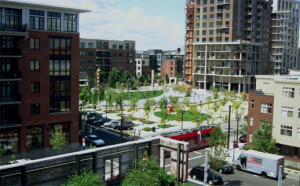Four senators introduce bill to help finance transit-oriented development

Building structured parking, public amenities and pedestrian-safe streets are part of the public infrastructure needed for successful economic development around transit.
Senators Brian Schatz (D-HI), Ed Markey (D-MA), Kirsten Gillibrand (D-NY) and Jeff Merkley (D-OR) have introduced an important bill to make it easier for communities to support economic development around transit stations.
For any community with a high-capacity transit line – subway, light rail, bus rapid transit – encouraging walkable development around the stations is a no-brainer. By attracting more potential riders, it makes the best use of the transit investment and helps to build the tax base.
Even more importantly, it helps to meet growing demand for homes and workplaces in neighborhoods with easy access to transit. And who is driving that demand? To a large degree it is the talented young workforce that every area is looking to recruit and retain. [See our poll with the Rockefeller Foundation] At the same time, a significant share of baby boomers is looking for similar things, as an American Planning Association poll showed this week.
Doing transit-oriented development right often means retrofitting streets so that they are safe and inviting for people on foot and provide good traffic flow, and building parking structures rather than surface lots, among other improvements. But it is the rare developer who has resources enough to finance the upfront costs of public infrastructure and utilities before the revenue from the finished development starts rolling in.
The Transit Oriented Development Infrastructure Financing Act would help provide low-cost financing in the form of loans or loan guarantees under the highly successful TIFIA program, which was expanded under MAP-21. Eligible borrowers, whether a state or local government or public-private partnership, would have to demonstrate a reliable, dedicated revenue source to repay the loan needed for public infrastructure.
This bill would help to support communities in creating public-private partnerships that help to spur economic development, build the local tax base, improve neighborhoods and infrastructure and make the most of transit investments. Senators Schatz, Markey, Merkley and Gillibrand are to be commended for their vision in introducing the TOD Infrastructure Financing Act.




















Pingback: Four senators introduce bill to help finance transit-oriented … | Next Blog - Financial News
Pingback: New Federal Bill Would Help Orient Communities Toward Transit | Streetsblog.net
Pingback: Today’s Headlines | Streetsblog USA